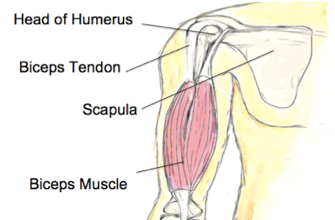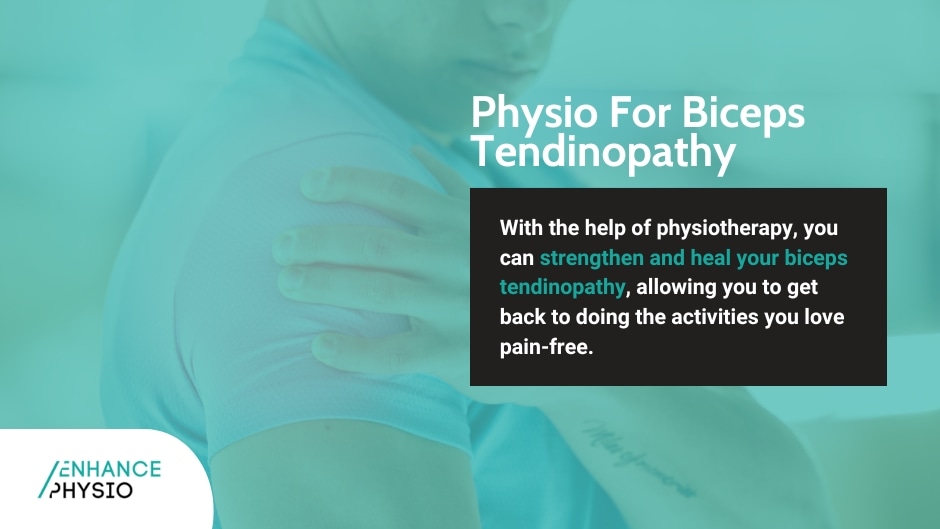Biceps tendinopathy can be a painful and frustrating condition that affects the tendons in the biceps muscle. If you're dealing with this issue, you may be wondering how to effectively treat it and get back to your normal activities. One of the most recommended treatment options for biceps tendinopathy is physiotherapy.
Physiotherapy is an effective treatment for this condition, helping individuals manage their symptoms and regain strength and function in their biceps.

The biceps brachii muscle, commonly known as the biceps, sits between the shoulder and elbow. It has two parts: the long head and the short head. These come together to form the main muscle bulk, the “Popeye” part of your upper arm.
The biceps brachii muscle runs from the top and front of the shoulder down to the upper forearm. The biceps tendon is the part that attaches the muscle to the bone both at the shoulder and the elbow.
The biceps muscle functions to bend the elbow and turn the hand to face palm-up. The term “tendinopathy” is used to describe the injury and pain of a tendon. This is most commonly due to overuse.
Biceps tendinitis tends to affect the long head of the biceps more commonly. Both the tendon itself and the tendon sheath can also be sources of pain.
Common causes of biceps tendinopathy
This condition occurs most commonly due to repeated use of the biceps over a long period of time. People with this condition often present in the later stages, when they begin to experience pain. This means that biceps tendinopathy is a slow-developing condition, without any symptoms until it reaches the point that the tissues become injured and painful. This is the body's way of self-defence; it is telling you that it doesn't like the activity you are asking it to do.
While specific tasks such as throwing sports, tennis or golf can increase the risk of developing biceps tendinopathy, it is often simply caused by usual daily activities throughout the course of an adult's life.
With age comes a decrease in the collagen and elastin components of tendons. This contributes to a reduced ability to sustain a high load, which can cause degeneration or inflammation over a longer period.

Common symptoms of biceps tendinopathy
Biceps tendinopathy is painful, sometime aching at night and increasing in intensity when performing overhead tasks such as reaching and lifting. The pain is usually at the front of the shoulder and can radiate downward along the front of the arm.
People with this condition often develop adaptations to their usual movement patterns in order to avoid aggravating this pain. This can lead to other issues, such as strained or overworked muscles.
An example of this is hitching up the shoulder to the ear when using the affected side, as this will help to offload the affected muscle, allowing the biceps to be under less stress.
Eventually, this will increase the stress on the muscles of the upper neck and shoulder, leading to secondary aches and pains.
Physiotherapy treatment for biceps tendinopathy
Enhance Physiotherapy's staff are experts in tendon pain and rehabilitation and are up-to-date with the latest evidence-based treatment techniques for tendon pain.
Your physiotherapist will assess and diagnose this condition, which allows for a comprehensive management plan to be put in place.
This could include activity moderation, electrotherapy, soft tissue treatments like massage and stretching, and progressing through a series of particular strengthening exercises.
Your physiotherapist will also be able to advise you on why you developed biceps tendinopathy and how to avoid a recurrence when you resume full activity.
If you have developed secondary complications with changes to your normal movement patterns, your physiotherapist can assist you in addressing these and training your body to avoid causing further damage.
If further imaging or an onward referral is needed, your physiotherapist can help guide you through this process.
What exercises should you avoid with bicep tendinopathy?
As you heal, avoid exercises that involve raising your arms high or in front of you. This might squeeze the biceps tendon, increasing the pain.
You should avoid exercises that can squeeze or overstretch your biceps tendon, such as:
- Overhead lifting
- Bicep curls
- Dips
- Heavy lifting
- Pressing movements

Final thoughts
Don't let biceps tendinopathy hold you back from living your best and most active life. With the help of physiotherapy, you can strengthen and heal your biceps tendinopathy, allowing you to get back to doing the activities you love pain-free.
Remember, it's important to listen to your body and seek professional guidance when dealing with any injury.
Book an appointment with one of our highly qualified physiotherapists at Enhance Physio before starting a rehabilitation program. We can advise you on the best course of action for your condition.

